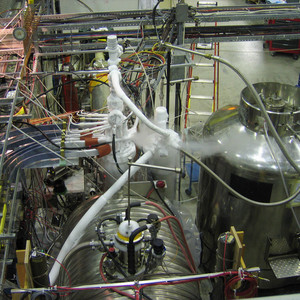Apr. 13, 2007 Research Highlight Physics / Astronomy
The anti-trap
First milestone achieved in building a suitable trap for antimatter
 Figure 1: A view of the ALPHA apparatus in operation. The iced cyrostat that holds the magnetic field trap for the antiparticles is visible in the center of the photograph. The vacuum tubes that deliver the positrons and antiprotons to the trap come in from the top and bottom of the image, respectively.
Figure 1: A view of the ALPHA apparatus in operation. The iced cyrostat that holds the magnetic field trap for the antiparticles is visible in the center of the photograph. The vacuum tubes that deliver the positrons and antiprotons to the trap come in from the top and bottom of the image, respectively.
When chemists study the different electronic excitations of atoms, the only equipment they need is a Bunsen burner. Sodium, for example, emits a very characteristic yellow light when heated by the flame of the burner. Unfortunately, when physicists study similar properties of antimatter they face much more of a challenge.
Antimatter, the counterpart of normal matter, is extremely rare to find in nature. To study whole antimatter atoms such as antihydrogen, which is composed of an antiproton and a positron (the positively charged opposite to the electron), these atoms need to be artificially created. For this, RIKEN has partnered with eleven other international institutions to form the ALPHA collaboration at the European Organization for Nuclear Research CERN in Switzerland.
The aim of ALPHA is to examine the electronic excitations in antihydrogen, similar to sodium’s yellow light. “Our purpose is to detect any tiny difference between antihydrogen atoms and hydrogen atoms,” explains Yasunori Yamazaki, the RIKEN project leader from the Discovery Research Institute in Wako.
To create and trap antihydrogen, antiprotons produced by particle accelerators and positrons from a radioactive source (22Na) are injected into the trap at the heart of the ALPHA apparatus (Fig. 1). As antimatter would be violently destroyed when brought into contact with normal matter, the trap consists of intricate magnetic force fields rather than a material such as steel. In an improvement on previous designs, “the magnetic field developed here has a much more uniform distribution near the axis of the magnet, while still maintaining the strong non-uniformity outside the trap that is necessary to trap neutral as well as charged particles,” says Yamazaki.
The teams’ first experimental results, now published in the journal Physical Review Letters 1, are very encouraging. Antiprotons as well as positrons were stored simultaneously in the trap for almost 10 minutes. However, researchers need to synthesize antihydrogen before they can start studying its fundamental properties. Then they need to develop a mechanism to continuously cool the atoms down to temperatures less than a degree above absolute zero so that they remain trapped.
Once this is achieved, the scientists can embark on their investigation into the differences between matter and antimatter. The implications of their work could be profound, as the slightest differences would mean the violation of one of the most fundamental symmetries of nature that predicts antimatter to be an exact mirror image of matter.
References
- 1. Andresen, G. Bertsche, W., Boston, A., Bowe, P., Cesar, C., Chapman S., Charlton, M., Chartier, M. Deutsch, A. Fajans, J. et al. Antimatter plasmas in a multipole trap for antihydrogen. Physical Review Letters 98, 023402 (2007). doi: 10.1103/PhysRevLett.98.023402
